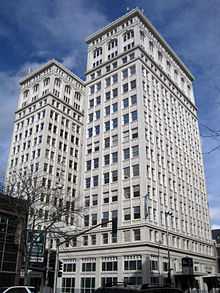Old National Bank Building
| Old National Bank Building | |
|---|---|
| General information | |
| Status | Complete |
| Location |
422–428 West Riverside Avenue Spokane, Washington |
| Coordinates | 47°39′30″N 117°25′08″W / 47.6582°N 117.4190°WCoordinates: 47°39′30″N 117°25′08″W / 47.6582°N 117.4190°W |
| Completed | 1911 |
| Height | |
| Roof | 217 ft (66 m) |
| Technical details | |
| Floor count | 16 |
| Design and construction | |
| Architect | D.H. Burnham & Company |
The Old National Bank building, located in Spokane, Washington, was completed in 1911 and was the first skyscraper located in the Inland Northwest. This fifteen story tower reaches to a height of 217 feet (66 m) above the Spokane valley and remained the tallest building in the city until the Paulsen Center was completed across the street on Riverside Ave. The Old National Bank building served as a symbol of prosperity for the rising economy of the Inland Empire.
History

In 1891, the Old National Bank of Spokane was founded. The bank quickly grew to be a large institution within the Inland Northwest and in 1910, decided to build a headquarters worthy of the Northwest. There was a national design competition to decide the buildings appearance. The winning design was awarded to D.H. Burnham & Company of Chicago, a notable firm for building some of Americas most famous buildings of the 20th century. The tower was built in the Chicago School style and had Beaux-Arts architecture features throughout the facade. This was the last office building to be designed by Burnham, with its completion being quickly followed by his death in 1912. The building broke ground in March 1910 and was completed a mere eight months later, opening its doors to the public in January 1911.
The Old National Bank building was notable for having 90 per cent of the building rented out to tenants at the time of its completion, and for being built having been financed by large bankers of the area, causing it to be built without a mortgage or deficit at a cost of $1,300,000. These happenings made the building, and the bank, worthy of the city of Spokane and the patrons who financed its construction, who gained valuable profit and recognition.
Architecture
The bank was built using fireproofed steel frame construction, with the exterior being faced with semi-enamel Terra Cotta. To enhance the contrast between the white Terra Cotta and the fenestration, the wood window frames were originally painted a forest green. The first level is topped with a four foot cornice of Vermont granite, eleven stories higher from the twelfth floor to the fifteenth floor, an arcade was implemented crowning the entire structure. A walk was provided on the roof for those who wanted to view the growing city from the sky.
The interiors were just as elaborate as the exteriors, at least at the time of their creation. There were two entrances off of Riverside Ave; the banking entrance and the office tower entrance. The banking entrance opens up to a grand lobby two levels in height. Granite ionic columns hold up the clerestory space being connected by service stations and tellers all facing the open lobby for ease of access by the people. The office tower entrance opens up immediately to the elevator lobby, servicing the other floors of the bank and the tenants in the rented spaces above. These five elevators were provided by the Otis Elevator Company, and ran smoothly up the entirety of the building with the help of live elevator operators. Two of these elevators service the first through ninth floors, two more service the eighth through the fourteenth floors, and the fifth elevator services the entire building. These elevator operations were planned to accommodate the best circulation of tenants throughout the building.
Banking Features
Some of the most notable features within the bank was not in its architecture or design, but in its operations. The facilities were state of the art and served Spokane with the highest quality equipment at the time, providing banking in the northwest with the maximum convenience it could. Another feature that caused the Old National Bank to stand out against the rest of the Inland Empire was featured in its basement, often out of public view. Directly within the banking entrance, the main stairs led down to the vault floor. The vault door was twenty-three inches thick and weighed thirty-six tons. This door guarded the largest private vault in the Northwest, a 27 by 9 foot room, with walls covered in three layers of laminated steel, Bessemer steel, and chrome steel, each layer being one and a half inches thick. Besides this main vault, there was a vault located on every floor of the building, each one being fire and burglar proof, proving to the community that whatever was kept in the building would be safe.
Renovations
The Old National Bank building has undergone two major renovations since its construction in 1910. The first renovation took place in the early 1920s. It consisted of turning the clerestory space into a mezzanine, allowing for the second floor to look down onto the lobby. The second renovation in the late 1963 dramatically altered the appearance of the interiors. The ceiling of the lobby was lowered, allowing for the first two floors of the bank to be pancaked on top of each other; the granite ionic columns were also stripped. After the 1963 renovation, the building took part in a lighting contest winning a national award, the entire facade of the building was lit up with fluorescent lights, glowing in the Spokane skyline. Today the Old National Bank building is occupied by US Bank.